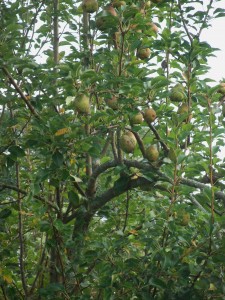
The always prolific, Kelly Pear
I’m reminded, when speaking of berries, fruit trees, and nut trees, of what a friend and fellow farmer, told me recently. “Tennessee is known as a place where you can grow anything … just nothing particularly well.” Our erratic annual chill hours in winter and high rainfall year-round, combined with our repressive summer heat and humidity, both inspire and conspire. Case in point: The olive trees I purchased after a series of warm winters arrived in time to witness two of the coldest on record. They reside to this day in the greenhouse of the friend mentioned above. Yet my optimism remains marginally undimmed, as the list below shows.
We have two primary orchards. The older, of apples, was planted in September 1999; the newer, more diverse, starting in 2012. Throughout the rest of the farm, we have tucked in little bits here and there, all in an effort to create a snacking environment, one that not only has gustatory appeal but that also adds resilience to our lives. And, we have planted dozens of ornamental and shade trees along the way.
Apple
- Arkansas Black
- Yarlington Mill
- Fox Whelp
- Kingston Black
- Magnum Bonum
- Super Red Fugi
- Grand Gala
- Golden Delicious
- Brayleet
- Horse
- Gala
- Honey Crisp
- June Red
- King David
- Calloway Crabapple
Pear
- June Sugar
- Seckel
- Kelly
Cherry (Montmorency)
Plum
- American
- Burbank
- Methley
Peach (Contender — fittingly, a lone survivor)
Quince
- Cook’s Jumbo
- Lisle
- Meech’s Prolific
Mayhaw (Big Red)
Fig (two orchards)
- Brown Turkey
- LSU Purple
- Yellow Long Neck
- Plus a few varieties I failed to record
Mulberry (small grove of four trees)
Elderberry (two groups of plantings)
Hazelnut (American, grove of eight)
Blackberry (thornless)
Blueberry (high bush)
Grape
- Concord
- Muscadine
- Scuppernong (technically a muscadine)
- Norton
- Lomanto
- Black Spanish
- Chambourcin
Pawpaw
We have a variety of cultivars and natives planted in two groups. The first is a small orchard on the edge of a wood, the second a dense planting in a wooded opening. The latter consists of native trees and is our attempt to establish them on our farm as naturally occurring. Native pawpaws are common to this area; we just haven’t found any on our farm.
Pecan (five varieties)
Gooseberry (two bushes)
Persimmon
Although we did not plant these, our farm is home to two large American persimmon trees. They overlook the farmyard area and are harvested yearly, if not by us, then certainly by the wildlife.
